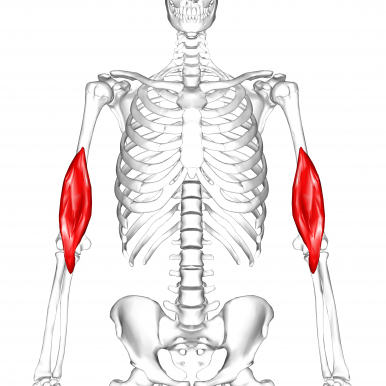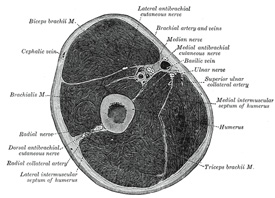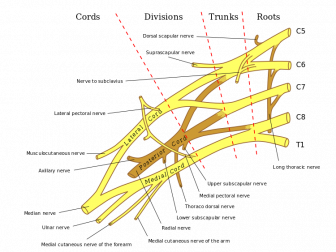Brachialis: Difference between revisions
Kim Jackson (talk | contribs) m (Text replacement - "[[Biceps brachii" to "[[Biceps Brachii") |
Kim Jackson (talk | contribs) m (Text replacement - "Brachial plexus" to "brachial plexus") |
||
| (4 intermediate revisions by 2 users not shown) | |||
| Line 1: | Line 1: | ||
<div class="editorbox">'''Original Editor '''- Eric Henderson | <div class="editorbox"> '''Original Editor '''- [[User:Eric Henderson |Eric Henderson ]] '''Top Contributors''' - {{Special:Contributors/{{FULLPAGENAME}}}}</div> | ||
== Description == | == Description == | ||
[[File:Brachialis muscle1.png|alt=|thumb|386x386px|The Brachialis Muscle<ref>Anatomography. English: Brachialis muscle. [Internet]. 2013 [cited 2018 Mar 21]. Available from: <nowiki>https://commons.wikimedia.org/wiki/File:Brachialis_muscle11.png</nowiki></ref> | [[File:Brachialis muscle1.png|alt=|thumb|386x386px|The Brachialis Muscle<ref>Anatomography. English: Brachialis muscle. [Internet]. 2013 [cited 2018 Mar 21]. Available from: <nowiki>https://commons.wikimedia.org/wiki/File:Brachialis_muscle11.png</nowiki></ref> | ||
]] | ]] | ||
The brachialis muscle is the primary flexor of the elbow. This muscle is located in the anterior compartment of the arm along with the [[Biceps Brachii]] and [[Coracobrachialis Muscle|coracobrachialis]]. | The brachialis muscle is the primary flexor of the elbow. This muscle is located in the anterior compartment of the arm along with the [[Biceps Brachii|biceps brachii]] and [[Coracobrachialis Muscle|coracobrachialis]]. | ||
=== Origin === | === Origin === | ||
Distal anterior aspect of the [[humerus]], deep to the biceps brachii.<ref name=":0">Brachialis [Internet]. [cited 2018 Mar 21]. Available from: | Distal anterior aspect of the [[humerus]], deep to the biceps brachii.<ref name=":0">Brachialis [Internet]. [cited 2018 Mar 21]. Available from: https://rad.washington.edu/muscle-atlas/brachialis/</ref> | ||
=== Insertion === | === Insertion === | ||
Coronoid process and the ulnar tuberosity.<ref name=":0" /> | Coronoid process and the ulnar tuberosity.<ref name=":0" /><ref name=":3">Kamineni S, Bachoura A, Behrens W, Kamineni E, Deane A. [https://downloads.hindawi.com/archive/2015/786508.pdf Distal insertional footprint of the brachialis muscle: 3D morphometric study]. Anatomy Research International. 2015;2015.</ref> | ||
=== Nerve === | === Nerve === | ||
The brachialis | The brachialis often has a dual innervation - medially innervated by the [[Musculocutaneous Nerve|musculocutaneous]] nerve and laterally by the [[radial nerve]]<ref name=":4">Plantz MA, Bordoni B. [https://www.ncbi.nlm.nih.gov/books/NBK551630/ Anatomy, Shoulder and Upper Limb, Brachialis Muscle.] [Updated 2022 Feb 22]. In: StatPearls [Internet]. Treasure Island (FL): StatPearls Publishing; 2022 Jan-. Available from: <nowiki>https://www.ncbi.nlm.nih.gov/books/NBK551630/</nowiki></ref>. The majority of the motor supply is supplied by the musculocutaneous nerve<ref name=":4" />. The radial nerve descends in the groove between the brachialis and [[brachioradialis]] muscles, above the elbow<ref name=":4" />. [[File:Brachial-plexus-2.png|thumb|336x336px]] | ||
</ref>[[File:Brachial-plexus-2.png|thumb|336x336px]] | |||
=== | === Blood supply === | ||
Tributaries of the brachial artery and the recurrent radial artery<ref name=":0" /><ref name=":4" />. Occasionally it is supplied by other arteries, such as branches from the ulnar collateral arteries<ref name=":4" />. | |||
== Function == | == Function == | ||
The brachialis | The brachialis is the major flexor of the elbow<ref name=":3" />. It has a large cross-sectional area, providing it with more strength than the biceps brachii and the coracobrachialis.<ref name=":2">Marieb EN, Hoehn K. Human anatomy & physiology. 10th ed. Boston, Ma: Pearson; 2016.</ref> In order to isolate the brachialis muscle the forearm needs to be in pronation, due to the biceps brachii's function as a supinator and flexor.<ref name=":2" /> By pronating the forearm the biceps is put into a mechanical disadvantage. | ||
[[File:Arm cross section.jpg|thumb|Cross Sectional View of the Upper Arm<ref name=":1" />|275x275px]] | [[File:Arm cross section.jpg|thumb|Cross Sectional View of the Upper Arm<ref name=":1">Gray, Henry. 1918. Anatomy of the Human Body [Internet]. [cited 2018 Mar 21]. Available from: [https://www.bartleby.com/107/124.html http://www.bartleby.com/107/] | ||
</ref>|275x275px]] | |||
== Clinical relevance == | == Clinical relevance == | ||
The brachialis muscle can be commonly injured by repetitive forceful contractions or muscular contractions with the arm in hyperextension. This is commonly seen in climbers, due to the pronation of the hand and the extended started position.<ref>Bond T. Tom’s Physiotherapy Blog: “Climber’s elbow” - Brachialis Tendonitis [Internet]. Tom’s Physiotherapy Blog. 2013 [cited 2018 Mar 21]. Available from: | The brachialis muscle can be commonly injured by repetitive forceful contractions or muscular contractions with the arm in hyperextension. This is commonly seen in climbers, due to the pronation of the hand and the extended started position.<ref>Bond T. Tom’s Physiotherapy Blog: “Climber’s elbow” - Brachialis Tendonitis [Internet]. Tom’s Physiotherapy Blog. 2013 [cited 2018 Mar 21]. Available from: http://thomasbondphysio.blogspot.com/2013/06/climbers-elbow-brachialis-tendonitis.html</ref> Physical activity that involves a lot of pull-ups, curls, and rope climbing can also initiate brachialis muscle pain.<ref>Brachialis muscle pain & trigger points [Internet]. [cited 2018 Mar 21]. Available from: https://www.muscle-joint-pain.com/trigger-points/trigger-point-self-treatment/brachialis/</ref> A strain to the brachialis tendon can also cause a patient to present with a lacking elbow extension due to painful end-range stretching of the tendon. Due to the location of the pain, [[Medial Epicondylitis|medial epicondylitis]] and [https://physio-pedia.com/Lateral_Epicondylitis lateral epicondylitis] should also be evaluated. | ||
The brachialis acts as the floor of the [[Cubital Fossa|cubital fossa]]<ref name=":1" />, and is part of the radial tunnel. It may be implicated in [[Erb's Palsy|Erb's palsy]] if the [[Brachial plexus]] becomes injured, leading to elbow flexion weakness. | The brachialis acts as the floor of the [[Cubital Fossa|cubital fossa]]<ref name=":1" />, and is part of the radial tunnel. It may be implicated in [[Erb's Palsy|Erb's palsy]] if the [[Brachial Plexus|brachial plexus]] becomes injured, leading to elbow flexion weakness. | ||
==Video== | ==Video== | ||
| Line 34: | Line 33: | ||
== Assessment == | == Assessment == | ||
To assess the strength of the brachialis place the elbow at 90 degrees of flexion with the forearm fully pronated. Then have the patient resist an inferior force placed on the distal forearm.<ref>Muscolino JE. Kinesiology: the skeletal system and muscle function. 2nd ed. St. Louis, MO: Mosby/Elsevier; 2011.</ref> | To assess the strength of the brachialis, place the elbow at 90 degrees of flexion with the forearm fully pronated. Then have the patient resist an inferior force placed on the distal forearm.<ref>Muscolino JE. Kinesiology: the skeletal system and muscle function. 2nd ed. St. Louis, MO: Mosby/Elsevier; 2011.</ref> | ||
{{#ev:youtube|bXt4DqXM6-8}} | {{#ev:youtube|bXt4DqXM6-8}} | ||
| Line 44: | Line 43: | ||
[[Category:Anatomy]] | [[Category:Anatomy]] | ||
[[Category:Muscles]] | [[Category:Muscles]] | ||
[[Category:Elbow - Muscles]] | |||
[[Category:Elbow - Anatomy]] | |||
Latest revision as of 19:01, 8 March 2024
Description[edit | edit source]

The brachialis muscle is the primary flexor of the elbow. This muscle is located in the anterior compartment of the arm along with the biceps brachii and coracobrachialis.
Origin[edit | edit source]
Distal anterior aspect of the humerus, deep to the biceps brachii.[2]
Insertion[edit | edit source]
Coronoid process and the ulnar tuberosity.[2][3]
Nerve[edit | edit source]
The brachialis often has a dual innervation - medially innervated by the musculocutaneous nerve and laterally by the radial nerve[4]. The majority of the motor supply is supplied by the musculocutaneous nerve[4]. The radial nerve descends in the groove between the brachialis and brachioradialis muscles, above the elbow[4].
Blood supply[edit | edit source]
Tributaries of the brachial artery and the recurrent radial artery[2][4]. Occasionally it is supplied by other arteries, such as branches from the ulnar collateral arteries[4].
Function[edit | edit source]
The brachialis is the major flexor of the elbow[3]. It has a large cross-sectional area, providing it with more strength than the biceps brachii and the coracobrachialis.[5] In order to isolate the brachialis muscle the forearm needs to be in pronation, due to the biceps brachii's function as a supinator and flexor.[5] By pronating the forearm the biceps is put into a mechanical disadvantage.

Clinical relevance[edit | edit source]
The brachialis muscle can be commonly injured by repetitive forceful contractions or muscular contractions with the arm in hyperextension. This is commonly seen in climbers, due to the pronation of the hand and the extended started position.[7] Physical activity that involves a lot of pull-ups, curls, and rope climbing can also initiate brachialis muscle pain.[8] A strain to the brachialis tendon can also cause a patient to present with a lacking elbow extension due to painful end-range stretching of the tendon. Due to the location of the pain, medial epicondylitis and lateral epicondylitis should also be evaluated.
The brachialis acts as the floor of the cubital fossa[6], and is part of the radial tunnel. It may be implicated in Erb's palsy if the brachial plexus becomes injured, leading to elbow flexion weakness.
Video[edit | edit source]
Assessment[edit | edit source]
To assess the strength of the brachialis, place the elbow at 90 degrees of flexion with the forearm fully pronated. Then have the patient resist an inferior force placed on the distal forearm.[9]
Resources[edit | edit source]
- ↑ Anatomography. English: Brachialis muscle. [Internet]. 2013 [cited 2018 Mar 21]. Available from: https://commons.wikimedia.org/wiki/File:Brachialis_muscle11.png
- ↑ 2.0 2.1 2.2 Brachialis [Internet]. [cited 2018 Mar 21]. Available from: https://rad.washington.edu/muscle-atlas/brachialis/
- ↑ 3.0 3.1 Kamineni S, Bachoura A, Behrens W, Kamineni E, Deane A. Distal insertional footprint of the brachialis muscle: 3D morphometric study. Anatomy Research International. 2015;2015.
- ↑ 4.0 4.1 4.2 4.3 4.4 Plantz MA, Bordoni B. Anatomy, Shoulder and Upper Limb, Brachialis Muscle. [Updated 2022 Feb 22]. In: StatPearls [Internet]. Treasure Island (FL): StatPearls Publishing; 2022 Jan-. Available from: https://www.ncbi.nlm.nih.gov/books/NBK551630/
- ↑ 5.0 5.1 Marieb EN, Hoehn K. Human anatomy & physiology. 10th ed. Boston, Ma: Pearson; 2016.
- ↑ 6.0 6.1 Gray, Henry. 1918. Anatomy of the Human Body [Internet]. [cited 2018 Mar 21]. Available from: http://www.bartleby.com/107/
- ↑ Bond T. Tom’s Physiotherapy Blog: “Climber’s elbow” - Brachialis Tendonitis [Internet]. Tom’s Physiotherapy Blog. 2013 [cited 2018 Mar 21]. Available from: http://thomasbondphysio.blogspot.com/2013/06/climbers-elbow-brachialis-tendonitis.html
- ↑ Brachialis muscle pain & trigger points [Internet]. [cited 2018 Mar 21]. Available from: https://www.muscle-joint-pain.com/trigger-points/trigger-point-self-treatment/brachialis/
- ↑ Muscolino JE. Kinesiology: the skeletal system and muscle function. 2nd ed. St. Louis, MO: Mosby/Elsevier; 2011.







